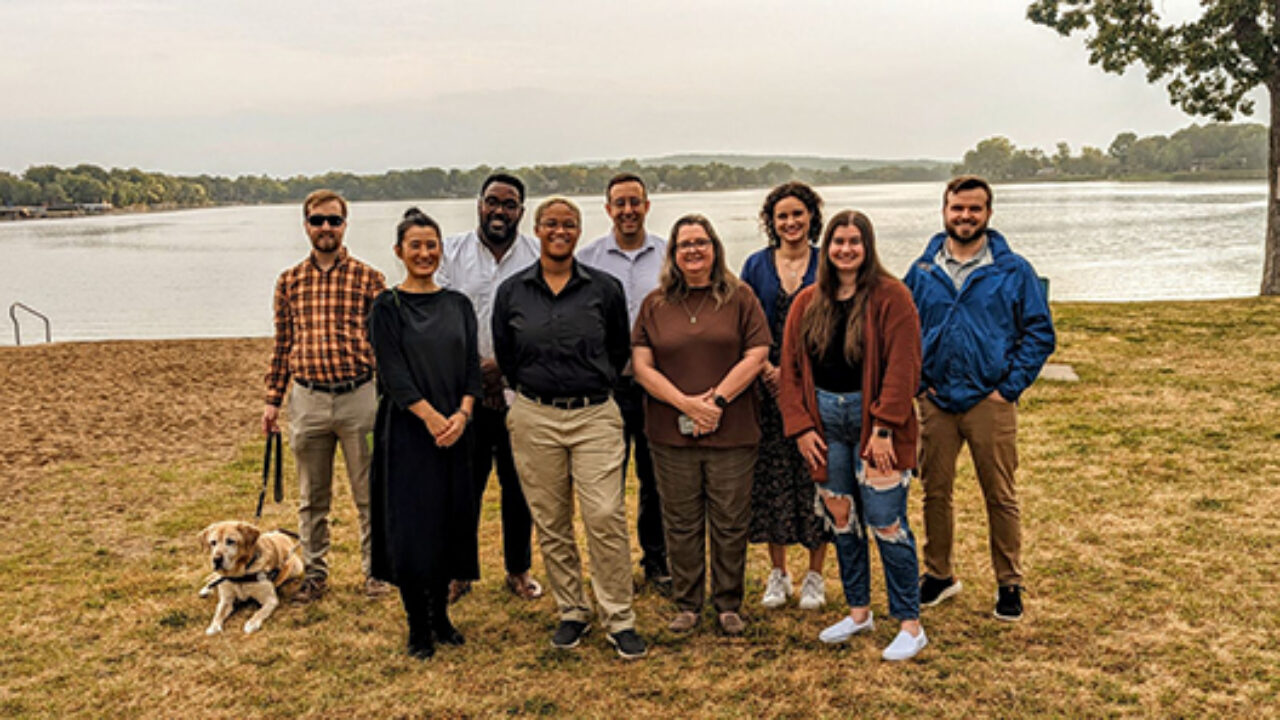What Meaning We Hold Together: Sacred Art in the Absence of Sight
When Rev. Tripp Gulledge, a blind pastor from Texas, experienced The Saint John’s Bible for the first time, he did so in community with fellow scholars from Dallas, Texas’ Southern Methodist University. The experience encouraged everyone in the room towards a deeper understanding of scripture.
The Saint John’s Bible Heritage Edition was never meant to be held by one person. Each volume stands at two feet tall and three feet wide when open, making it nearly as tall, or taller than, half of most human bodies. This makes holding all seven volumes by oneself extremely difficult. At best, it’s uncomfortable. At worst, it’s impossible.
Just as the physical volumes themselves require a community to hold, so does the art and scripture that lay within. Rev. Robert “Tripp” Gulledge, knows this well. Gulledge is a pastor, theologian, scholar, and creative. He is also a blind person.
Gulledge was diagnosed with a condition called retinopathy of prematurity as an infant, which caused his retinas to detach and deteriorate. He underwent surgery that saved some of his vision at six weeks old, but, at age 13, his retina began to deteriorate again. In hopes of saving some of his vision, Gulledge underwent another surgery to prevent further deterioration. His doctors hope that in 10 to 15 years or so, medicine will have advanced so that there is a long-term solution for Gulledge. In the meantime, he cannot see.

In September 2023, Gulledge (then a first year Master of Theology student) and a small group of students and faculty from the MAST+ (ministers, artists, scholars, teachers, and more) program at Southern Methodist University in University Park, Texas, visited Saint John’s University in Collegeville, Minnesota for a faculty and student retreat experience following the University’s acquisition of a Heritage Edition earlier that year. The MAST+ program is designed to help people who feel called into vocational ministry to articulate ways to use creativity to bless their congregations, their ministry settings, and the world at large. For Gulledge, that means creating liturgical resources to help others facilitate or lead worship.
Equal parts theologian, spiritual director, and creative, Gulledge eagerly anticipated experiencing The Saint John’s Bible in person. So, on the Friday morning that Tim Ternes, Director of The Saint John’s Bible and Hill Manuscript & Museum (HMML) programming, was scheduled to introduce the group to The Saint John’s Bible and show the group the original manuscript, he was thrilled.
What do you see? What do we see together?
Ternes began the presentation by projecting scripture passages onto a screen, reading them aloud, and asking the group what the passages might look like if the words were made into images.
After a brief imaginative discussion, Ternes projected the illumination of John 1 from The Saint John’s Bible. The group was eager to share their thoughts on the illumination: how it made them feel, what they thought certain motifs meant, what those motifs reminded them of but Ternes stopped them. “Stop,” he said. “What do you see? Make sure you name everything you see first before you interpret.”
Ternes, one of the foremost experts on The Saint John’s Bible, was unrelenting in this. If a guest skipped a few steps and ventured into interpretive territory, he would encourage them to re-ground themselves in the art piece. “Be more specific,” he said. “What is it exactly that you are looking at?”
“This really resonated with me as a pastor, a spiritual director, and, of course, it was meaningful and helpful to me as a blind person,” said Gulledge. “To have very thorough descriptions of the illuminations in a way that the typical museum curation experience doesn’t provide was really special. Just like none of us could do this practice of the Christian faith alone. I couldn’t have had that experience without everyone else in the room.”
This exercise wasn’t only important for Gulledge. It was important for everybody there. Similar to how meditation situates a person in a space and in their body, the practice of starting at the very first level what do you see brought a certain presence to the illumination. Once this presence was established, deeper interpretive questions arose from the group. As each person contributed their insights, the meaning held by the group became at once heavier, in terms of density of analysis, and lighter, because the group shared the weight of that meaning.
“As a spiritual director, somebody who sits and listens for the presence and the movement of God in the lives of other people, you have to notice everything. I could sit there with John 1 and read it and then close my eyes and picture it for 10 minutes. But it was made so much richer by the fact that my friends and I eventually were able to work together and share in an environment where nobody gets made to feel like their interpretation is incorrect or they miss something,” said Gulledge. “The way that Tim led us through the interpretation of the illumination…people should be doing that all the time.”
In addition to a deeper understanding of the work, there was also a sense of safety in the room. According to Gulledge, there’s something about using art as a vehicle to approach the Word of God that allows for a level of boundless exploration that the absence of creative expression does not.
“In this exercise, there was a real recognition of how the lives we live influence the way that we approach scripture in a way that is different from anybody else,” said Gulledge. “When we allow people to experience the Bible in community, we put that world view into practice.”
For more stories similar to this one, visit the Heritage Program blog or subscribe to our monthly e-newsletter, Sharing the Word.


